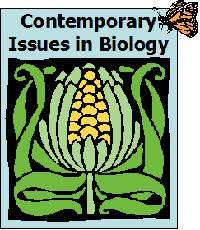Chapter 8 Sample Assignment:
- I chose SCID (Severe Combined Immunodeficiency Disorder) because the book
uses it as an example and it is therefore not available to students
for this assignment. Also, I find immune system diseases interesting
because I am amazed at how well the body fights off the diseases that are
literally everywhere.
- SCID affects the immune system.
- A person with SCID basically has no immune system because he or she cannot
produce white blood cells. He or she is therefore unable to fight off disease.
So the symptoms of SCID are essentially the symptoms of whatever disease is
afflicting the patient. SCID affects about 1 in one million people, and it usually appears in infancy. If untreated, the disease causes death in the first year of life. Bone
marrow transplants or gene therapy, especially before 6 months of age, often
extend the lifespan to normal.
- SCID is a set of disorders, not just one. This makes sense because the
production of white blood cells takes many steps, and interfering with just
one step might stop them from being produced entirely. A mutation in any
of at least three genes can lead to SCID.
- Genes contributing to SCID are on chromosomes 19, 20, and X (about 50% of cases are
X-linked). Autosomal forms affect males and females equally; the X-linked form is
more common in males than females.
- The SCID-linked gene on the X chromosome codes for a protein that activates
a second protein, which is important in the development of T-cells (a type
of white blood cell). (A mutation in the gene for this second protein is one
of the other causes of SCID).
- The X-linked gene causes disease because it indirectly interferes with
T-cell production. T cells are white blood cells that identify invading pathogens
and help coordinate the activities of other immune system cells. The lack
of T-cells does not, in and of itself, cause disease – but it leaves
the victim unable to fight off infections by many types of viruses, bacteria,
and fungi.
- The X-linked gene is inherited in an X-linked recessive pattern.
- Along with antibiotic, antiviral, or antifungal drugs to combat specific
infections, the preferred treatment is a bone marrow transplant from a matched
sibling or parent during the first few months of age. This will provide functioning
immune system cells. If an appropriate bone marrow match is not available,
gene therapy is another option. Stem cells modified with a gene that restores
immune function can yield a healthy immune system. Some gene therapy patients,
however, subsequently develop leukemia.
- If a genetic test were available, I would certainly recommend it to my friend. Early detection and treatment is the key to fighting SCID. If my friend knew that her baby would be born with SCID, she could start bone marrow transplants or gene therapy as soon as it was safe to do so, and she would therefore fight the disease from the beginning instead of waiting for her child to get sick.
[503 words before references]
References
National Institute of Allergy and Infectious Diseases. 2003. Primary Immune
Deficiency. http://www.niaid.nih.gov/factsheets/pid.htm#xlinked.
Downloaded July 23, 2004.
NCBI. Undated. Severe Combined Immunodeficiency. http://www.ncbi.nlm.nih.gov/books/bv.fcgi?call=bv.View..ShowSection&rid=gnd.section.153 Downloaded July 23, 2004.
O'Neill Shigeoka, Ann, M.D. 2003. Severe Combined Immunodeficiency. http://www.emedicine.com/ped/topic2083.htm.
Downloaded July 23, 2004.
Online Mendelian Inheritance in Man. 1986 (updated most recently in 2010).
SEVERE COMBINED IMMUNODEFICIENCY, X-LINKED; SCIDX1 http://omim.org/entry/300400. Downloaded July 23, 2004.
[Back to Digging Deeper Assignment]
[Sample assignment by Mariëlle Hoefnagels]
 |
Contemporary Issues in Biology -- BIOL 1003
Mariëlle H. Hoefnagels, Ph.D. © 2004-2015.
biology1003 at OU dot edu (at = @, dot =.)
Last Updated
August 5, 2014 11:02 PM
|

|

